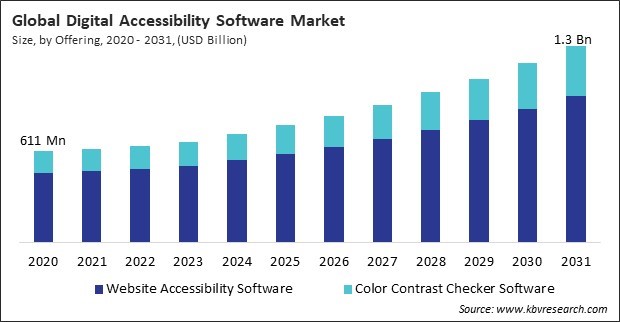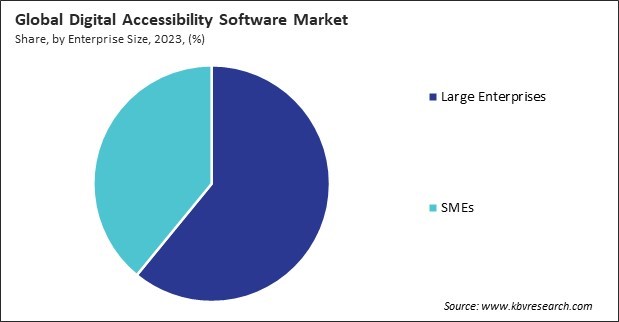“Global Digital Accessibility Software Market to reach a market value of USD 1.3 Billion by 2031 growing at a CAGR of 8.9%”
The Global Digital Accessibility Software Market size is expected to reach $1.3 billion by 2031, rising at a market growth of 8.9% CAGR during the forecast period.
European nations have long been advocates of inclusivity, and businesses are increasingly investing in digital accessibility to comply with evolving regulations and meet the needs of a diverse population. The introduction of comprehensive regulatory frameworks, such as the European Accessibility Act (EAA), has significantly driven the demand for accessibility software across the region. Hence, the Europe segment garnered 31% revenue share in the market in 2023. Sectors such as government services, retail, and education have been particularly active in adopting accessibility software as they strive to create equitable digital environments for all users. The region’s focus on technological innovation, coupled with strong enforcement of accessibility laws, has made Europe a key player in the global accessibility software market.

As businesses and governments continue to transition their operations online, there is a growing recognition of the necessity of developing digital platforms that are accessible to all individuals, irrespective of their cognitive or physical capabilities. This shift in mindset is about meeting regulatory requirements and creating equitable access to websites, mobile applications, and other digital resources. Moreover, companies that fail to create inclusive digital experiences risk alienating customers, which can hurt their market reputation and bottom line. Companies’ awareness grows, companies across industries invest in technologies and best practices to ensure their digital platforms are fully accessible, leading to the rising demand for digital accessibility software.
Moreover, it has become essential for businesses to guarantee that their mobile applications are accessible to all consumers, including those with disabilities, in light of the fact that billions of individuals utilize smartphones and tablets to access digital content and services. This development is particularly significant because mobile devices have become the major tool that individuals use to obtain information, communicate with one another, and complete tasks and responsibilities that they encounter on a daily basis. Therefore, the increased focus on mobile accessibility will aid in expanding the market.
However, when a company adopts digital accessibility measures, the initial financial outlay can be substantial. This includes not only the purchase price of the software but also the cost of integrating it into the existing technological infrastructure. Integration requires specialized expertise to ensure the software works seamlessly with other systems. These experts not only monitor and maintain the accessibility of software but also help navigate complex regulations to avoid legal penalties, which can be expensive. As accessibility laws become stricter, failing to maintain compliance can lead to lawsuits or fines, further increasing the financial risk for businesses. Hence, the cost of implementation hampers the growth of the market.
Based on offering, the market is bifurcated into website accessibility software and color contrast checker software. The color contrast checker software segment procured 24% revenue share in the market in 2023. Color contrast is critical to ensuring that digital content is readable and accessible to individuals with visual impairments, particularly those with color blindness or low vision. Color contrast checker software allows developers and designers to ensure that text, images, and other visual elements on a website meet the necessary contrast ratios required for readability and compliance with accessibility guidelines.

On the basis of enterprise size, the market is classified into SMEs and large enterprises. The large enterprises segment acquired 61% revenue share in the market in 2023. Large enterprises, particularly in the finance, healthcare, retail, and telecommunications sectors, have a greater focus on comprehensive digital accessibility strategies due to regulatory pressures, legal compliance requirements, and a broad, diverse customer base.
Free Valuable Insights: Global Digital Accessibility Software Market size to reach USD 1.3 Billion by 2031
Region-wise, the market is analyzed across North America, Europe, Asia Pacific, and LAMEA. The North America segment witnessed 42% revenue share in the market in 2023. This dominance is the result of a variety of factors, including the Americans with Disabilities Act (ADA), which dictates that digital platforms and services must be accessible to individuals with disabilities. Additionally, the region's mature technological infrastructure and the growing emphasis on corporate social responsibility (CSR) have spurred businesses and organizations to invest in accessibility solutions.
| Report Attribute | Details |
|---|---|
| Market size value in 2023 | USD 671.7 Million |
| Market size forecast in 2031 | USD 1.3 Billion |
| Base Year | 2023 |
| Historical Period | 2020 to 2022 |
| Forecast Period | 2024 to 2031 |
| Revenue Growth Rate | CAGR of 8.9% from 2024 to 2031 |
| Number of Pages | 157 |
| Number of Tables | 240 |
| Report coverage | Market Trends, Revenue Estimation and Forecast, Segmentation Analysis, Regional and Country Breakdown, Porter’s 5 Forces Analysis, Company Profiling, Companies Strategic Developments, SWOT Analysis, Winning Imperatives |
| Segments covered | Offering, Enterprise Size, Region |
| Country scope |
|
| Companies Included | accessiBe Inc., AccessibilityChecker.org INC., AudioEye, Inc., Axess Lab, Deque Systems, Inc., Evinced Inc., Level Access Inc., Silktide Ltd, Siteimprove A/S (Nordic Capital Limited), UsableNet Inc. |
By Offering
By Enterprise Size
By Geography
This Market size is expected to reach $1.3 billion by 2031.
Rising Demand for Inclusive Digital Experiences are driving the Market in coming years, however, High Costs of Implementation restraints the growth of the Market.
accessiBe Inc., AccessibilityChecker.org INC., AudioEye, Inc., Axess Lab, Deque Systems, Inc., Evinced Inc., Level Access Inc., Silktide Ltd, Siteimprove A/S (Nordic Capital Limited), UsableNet Inc.
The expected CAGR of this Market is 8.9% from 2024 to 2031.
The Website Accessibility Software segment is leading the dominated the Market by Offering in 2023; thereby, achieving a market value of $977.1 Million by 2031.
The North America region dominated the Market by Region in 2023; thereby, achieving a market value of $535.1 Million by 2031.
Our team of dedicated experts can provide you with attractive expansion opportunities for your business.

 Drivers
Drivers
 Restraints
Restraints
 Opportunities
Opportunities
 Challenges
Challenges
